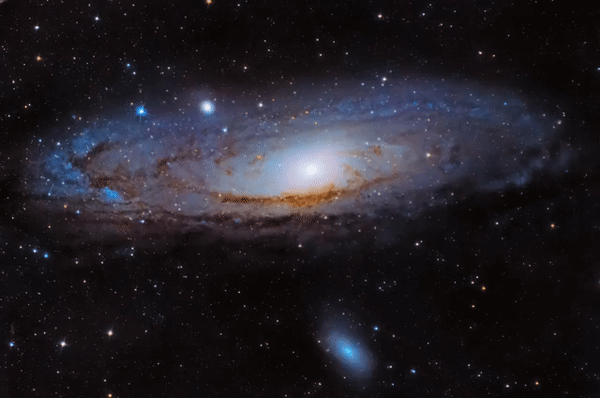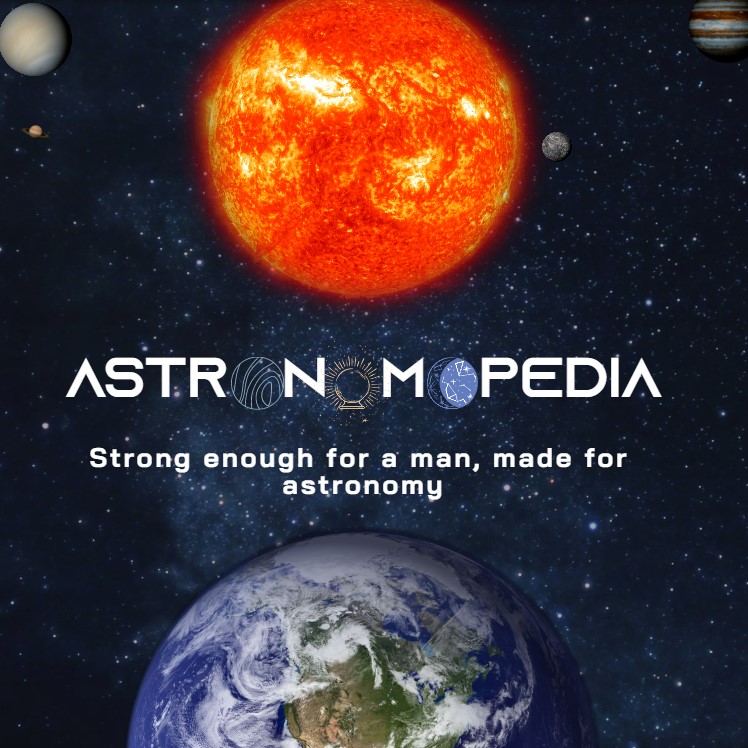

Andromeda

What is Andromeda?
Also known as Messier 31, M31, or NGC 224, Andromeda is an elliptic galaxy and is considered the largest galaxy in the Local Group, a collection of galaxies that includes the Milky Way. With its immense size, more than double the size of our home – the Milky Way, and mass, Andromeda is a truly remarkable cosmic entity, containing approximately a trillion stars within its vast expanse.
Morphology
Dimensions
Andromeda has a diameter of around 200,000 light-years (1,892,146,000,000,000,000 km or 1,175,725,015,907,102,464 miles) and is estimated to be about 1,000 light-years thick. It covers an area of 691,150.38379 light-years² (2,972,176,000,000,000,000 km² or 1,147,563,569,168,052,480 miles²).
Anatomy
The Andromeda galaxy has a fascinating anatomy with various components. At its core, there is a supermassive black hole, which plays an important role in the galaxy's structure. Surrounding the core, Andromeda features beautiful spiral arms that extend outward and contain numerous stars, gas, and dust. These spiral arms give the galaxy its distinct appearance. Additionally, Andromeda has a large halo of hot gas, which makes up about half the mass of all the stars within the galaxy. Weighing at ~ 12.3⁺¹⁸₋₆ x 10¹¹ M☉, this invisible halo stretches for about a million light-years and extends about halfway to our Milky Way Galaxy.
Moreover, the total mass estimates of Andromeda range from about 800 billion solar masses up to 1.5 trillion solar masses, with uncertainties due to different calculation techniques. Notably, Andromeda's mass is found to be approximately 800 billion times the mass of the Sun, making it comparable in mass to our Milky Way galaxy. To determine this mass, scientists employed a technique based on escape velocity, which calculates the speed required for a fast-moving star to break free from its host galaxy's gravitational pull.
Stellar populations
The Andromeda galaxy hosts a wide range of stellar populations that encompass stars of varying ages, compositions, and evolutionary stages. These populations include both young, recently formed stars found in active star-forming regions, as well as older, evolved stars that have exhausted their nuclear fuel and progressed through their life cycles.
Clusters of young stars can be observed in regions where active star formation occurs, often characterized by areas of intense brightness and nebulae. These regions provide valuable insights into the ongoing processes of star birth and early evolution. In contrast, the older stellar populations are distributed throughout the galaxy, forming a diffuse and dispersed collection of stars that have undergone various stages of stellar evolution. These evolved stars can offer significant information about the history and evolution of the Andromeda galaxy, allowing astronomers to unravel its past interactions with other galaxies and to infer its formation and growth over billions of years.
Spiral arms
The Andromeda galaxy is renowned for its stunning spiral structure, which consists of magnificent arms that gracefully wind around its central bulge. These spiral arms are prominent features that extend outward from the galaxy’s center, and they play a crucial role in shaping its overall structure and dynamics. The spiral arms are composed of billions of stars, gas, and dust, creating a magnificent tapestry of cosmic beauty.
The formation and maintenance of spiral arms in galaxies like Andromeda are complex processes that involve various factors, including gravitational interactions and density waves. As stars and gas move through the galaxy, they can become caught in regions of higher density, leading to the formation of spiral arms. Additionally, the gravitational pull of stars and other matter within the galaxy can help maintain and shape the arms over time.
Location
Andromeda is situated at an approximate distance of 2.5 million light-years away from Earth and the Milky Way. This vast separation places Andromeda within our cosmic neighborhood, making it the closest major galaxy to our own.
The precise celestial coordinates of Andromeda are as follows: Right Ascension (RA) 0h 42.7m and Declination (Dec) 41° 16' north. Right Ascension represents the angular distance of an object along the celestial equator from the March Equinox, while Declination is the angular distance north or south of the celestial equator. As a reference point, the March Equinox lies within the constellation of Pisces.
Physico-chemical properties
Andromeda is predominantly composed of dark matter, which makes up a substantial portion of its volume and mass. This abundance of dark matter plays a crucial role in holding the galaxy together due to its powerful gravitational influence. In addition to dark matter, Andromeda also contains various components, including dust particles, gas (whose precise composition is yet to be fully identified), and a mixture of other planetary particles. The study of these physico-chemical properties provides valuable insights into the fundamental characteristics of Andromeda and the intricate interplay between its different components. Understanding the composition of galaxies like Andromeda enhances our understanding of the larger cosmic structures and the complex processes shaping the universe.
Age
Andromeda is estimated to have an age of approximately 10,000,000,000 terrestrial years (10 billion years old).
Force fields

Magnetic field
In a groundbreaking effort, astronomers at MPIfR (Max Planck Institute for Radio Astronomy) have successfully generated the most comprehensive and intricate map of the magnetic fields permeating the Andromeda Galaxy. Employing the powerful capabilities of the Effelsberg telescope, this study has shed light on the magnetic landscape within Andromeda. The magnetic fields in this galaxy are found to extend in a wide and expansive ring, spanning an impressive diameter ranging from 40,000 to 100,000 light years.
The image on the right depicts the directional orientation of the magnetic field in M31, which has been deduced by analyzing the Faraday rotation of polarization angles between wavelengths of 3.6 cm and 6.2 cm, with an angular resolution of 3 arcminutes. In the visualization, the blue color signifies a clockwise rotation, indicating that the magnetic field points away from us, while the red color indicates a counter-clockwise rotation, suggesting that the magnetic field points towards us.
Gravitational force
The gravitational force of Andromeda on the Milky Way has been estimated to be approximately F = 2.4 × 10³⁰ kg. This force is a result of the mutual gravitational interaction between the two galaxies due to their mass and proximity. The gravitational force between Andromeda and the Milky Way plays a crucial role in their orbital dynamics and overall interaction within the Local Group of galaxies.
Motions

Rotation
The study of the rotation curve of the Andromeda Galaxy reveals some intriguing characteristics. The rotation curve remains flat up to the distance at which the stars become too faint to accurately determine the rotation curve. The galaxy's rotational velocity experiences fluctuations along its radial distance. It increases to a local maximum of approximately 250 km/s at a distance of 14 kiloparsecs (kpc), then decreases slightly to a local minimum of 220 km/s at 25 kpc, and finally rises again to reach a maximum of about 260 km/s at a distance of 40 kpc.
The spiral pattern of the galaxy's arms rotates in a manner that appears against the backdrop of the surrounding field stars, exhibiting periods of rotation that span approximately 100,000 years. The rotation curve and the behavior of the spiral pattern provide valuable insights into the mass distribution and dynamics of the Andromeda Galaxy.
Galactic Collisions
Galactic collisions are a relatively common phenomenon in the vast expanse of the universe, and the Andromeda Galaxy is currently heading for a dramatic collision with our own Milky Way galaxy. Such collisions have significant implications for the evolution of galaxies. One of the remarkable effects is the triggering of star formation as the two galaxies interact, leading to the birth of new stars. The collision process can also give rise to intriguing structures like tidal tails and bridges, formed as a result of gravitational interactions between the merging galaxies.
Author: William Homier
Editor: William Homier
Sound credit goes to Nano Vibrational Relations.
This page was last edited on 29 July 2023, at 14:19 (HAE).
Sources:

